Jim, Michele, Simon and I flew out of Palermo mid-morning Tuesday, arriving Rome before noon. Our transportation took us directly to our apartment where after dropping off bags, we headed out first for lunch and then to the Colosseum. The Colosseo is maybe 1/4 mile from the apartment.
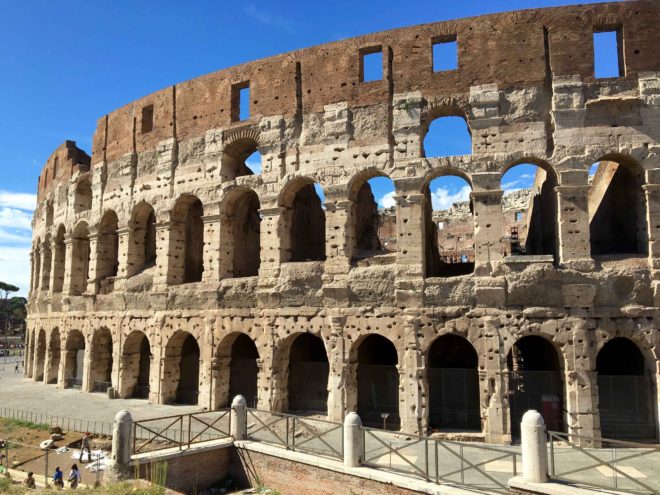
The Colosseo. Built 72 – 80 AD, it could seat about 70,000 people and was designed so everyone could exit within 15-20 minutes. Another little known fact is that for several years, water from the viaducts was used to flood the lower levels and mock sea battles with boats were conducted in that man-made “sea.”
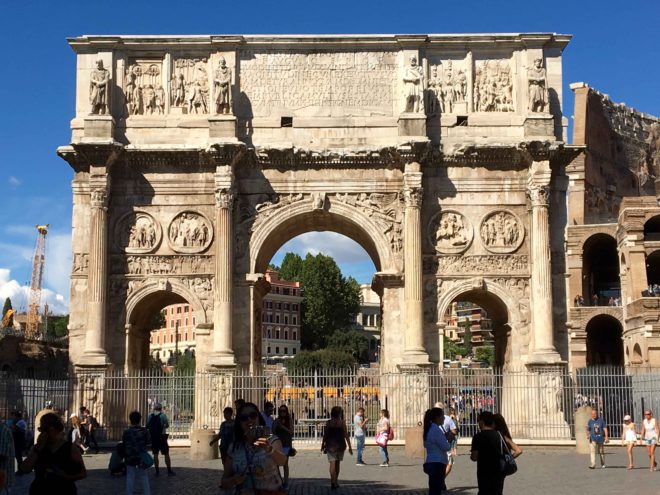
Outside the Coliseum is the Arch of Constantine, an 80 foot high monument built in AD315 to mark the victory of Constantine over Maxentius
After we walked around the Colosseum, Simon connected us with a tour guide which turned out to be a wonderful decision — at least for the other three because my leg had begun to bother me so I found a bench and sat out climbing stairs and walking around the rough terrain and terraces of the Colosseum.
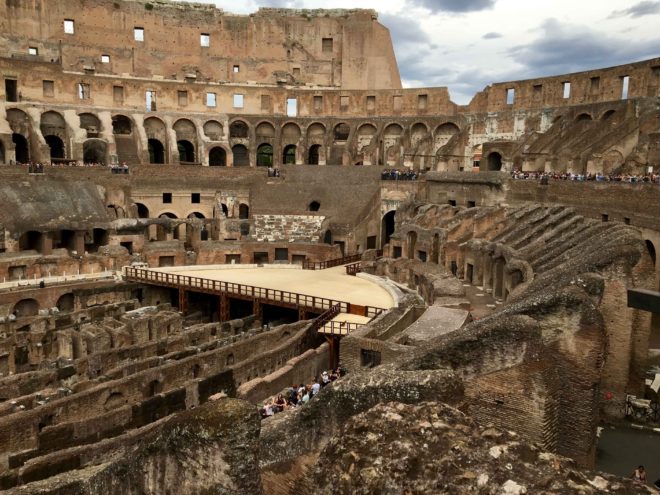
Inside the Colosseo. That tan platform is a reconstruction of where the actual “stage” or “fighting field” was located. The structure below that level was for moving gladiators, animals, support teams or in some cases, water for the spectacles.
According to Michele and the boys, there are hundreds of things about the Colosseo that most people have never heard, such as conducting mock sea battles inside the amphitheater. Also, there was a “flying sail” arrangement whereby “sails” could be raised and adjusted to provide spectators protection from the sun or rain. However, only certain, certified sailors were permitted to operate the sail system. Or, it wasn’t the emperors who arranged the shows or fights in the Colosseo — it was other sponsors, people who had the money to buy advertising, rent the gladiators from a variety of schools, provide food for the spectators, and on, and on, and on. We recommend doing a little studying before you go, or just pay the 15-30 Euro fee and get a guide.
Oh, scroll back up to the first photo of the Colesseo and note the hundreds of smaller holes in the walls — look like woodpeckers made them. Actually, there was a long time when the Colosseo was abandoned; and in other times it was used used for housing or shops. But in Medieval times, metal was in short supply and since the original builders of the Colosseo had used metal fittings to initially place the large stones, scroungers dug into the walls and extracted any metal they could find, selling it for other sustenance. I’m glad we take a little better care of historical sites nowadays.
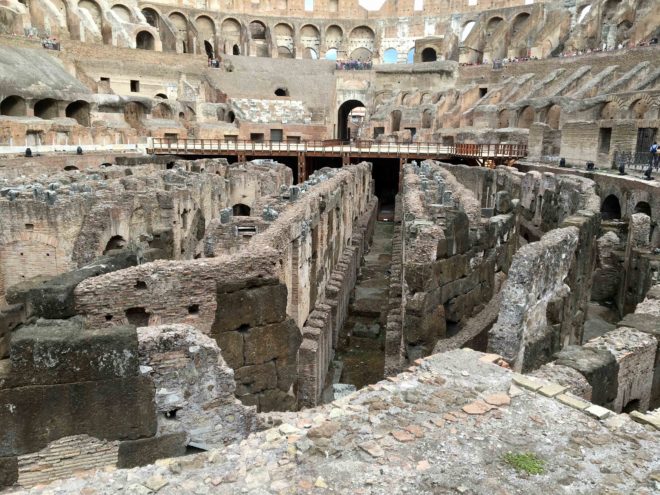
Pathways to move around, rooms to hold wild animals (and gladiators), elevator shafts — it is an amazing maze below the actual floor.
Having Simon along, a Roman/Italian history buff himself, was a blessing. Jim told me Simon verified that the guide here and on other tours we took was telling the history and facts exactly as he, Simon, learned them at university.
On Wednesday, we headed over to the Vatican, taking the subway to a station just outside the Vatican museum. We had forgotten that it was on Wednesdays however that the Pope conducts an audience in the piazza and that the Basilica is closed until 1:00 PM. Tickets are required for the audience so we were out of luck there. We hooked up with another guide who took us through the Vatican Museum and the Sistine Chapel, all timed to finish up around 1:15 so we could go straight from the Sistine Chapel into the Basilica. Again, the combination of Simon and a good guide (Simon certified!) made the difference. Even though we Altemoses had been through the museum a few years ago, the tour taught us a great deal more.
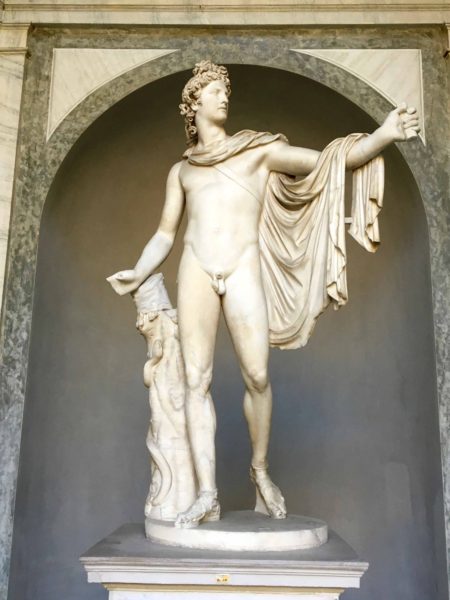
Statue of Apollo, a Roman copy sculpted in 130 AD after the Greek original from 4th Century BC. Arguably the most famous statue in the world.
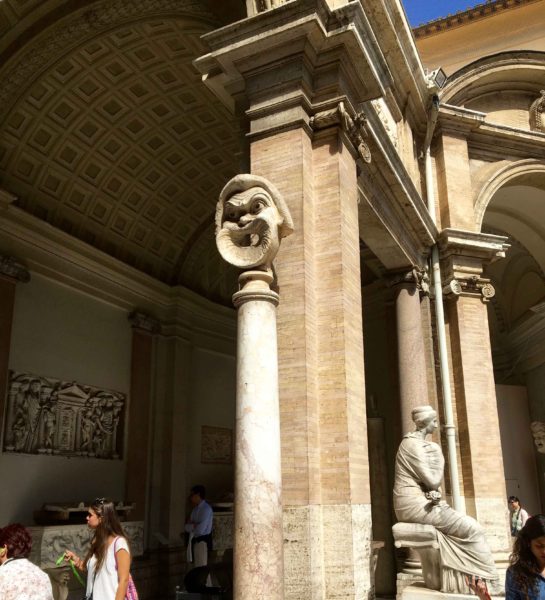
One of these guys on each side of the “Music Room” which houses a huge variety of statues.
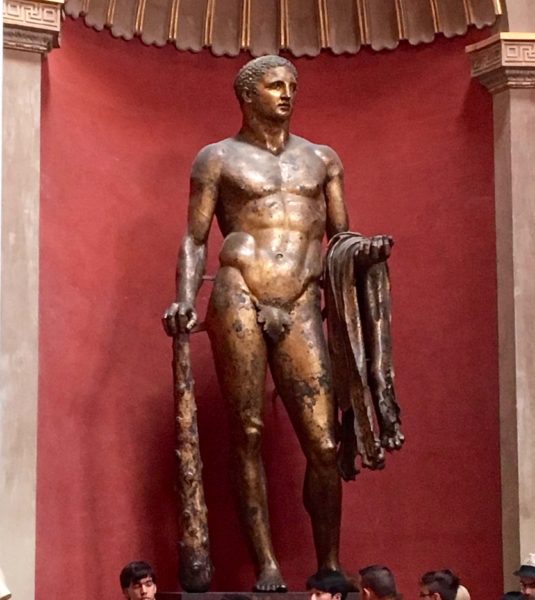
And then there is Hercules.
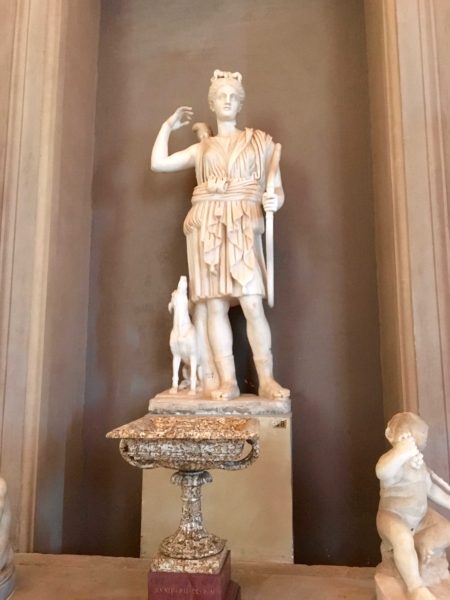
Diana is another beautiful statue, but like many statues in the Vatican Museum, it is a reproduction of an older, Greek statue.
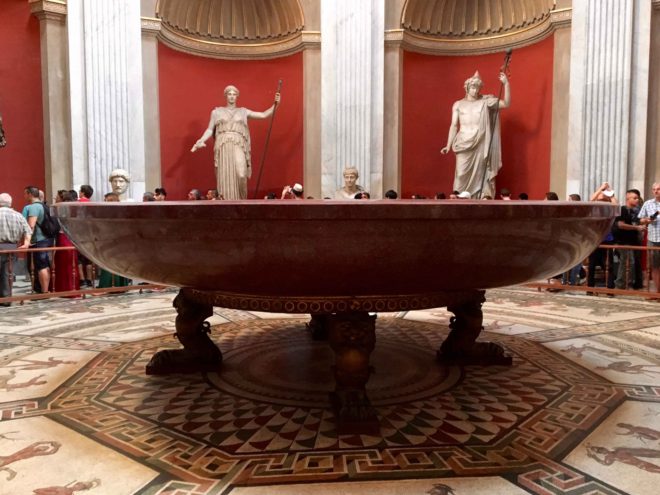
Nero’s Bathtub. It is the largest unit of Purple, or Imperial, Porphyry in the world and was carved from a single block.
And another aspect. I think everyone has heard it said that the Catholic Church is hugely wealthy. Well, it is but one must measure that wealth in terms of the priceless statuary and art work, the buildings and the artifacts owned and cared for by the church, both in Rome and elsewhere.
We kept moving along, saw amazing tapestries, entered a series of apartments with artwork by Rafael, and then entered the Sistine Chapel. No photos permitted and the guards are constantly asking everyone to be quiet. It is a beautiful room and ceiling but there are other places we think are more beautiful. The beauty of the Sistine Chapel is due in part to the religious significance of the paintings and the manner in which Michelangelo and others created and painted the room. Still, it should not be missed on any visit to Rome.
As advertised, we moved right along into St. Peter’s Basilica. Thinking we were at the front end of the reopening of the Basilica after the morning audience, we were amazed at the number of tourists already in the church. We were also amazed at how much had changed since we were last here. So much more of the church has been cordoned off, limiting access. In 2007, we were able to walk right up to the edge of the stairs down to the crypt where St Peter is buried. This year, you could not get closer to those stairs than about 25 yards.
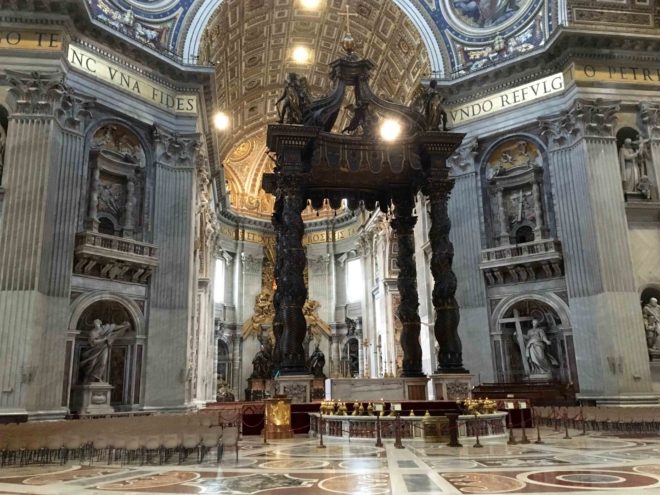
In the Basilica of St. Peter’s near the high altar. St Peter’s crypt is below the altar. On our last visit, one could walk right up to that railing around the altar and crypt.
We’ve come to realize that there are many more people in the world now and that while not all are wealthy, there are a bunch more who can afford to travel and therefore we are going to have to contend with many more tourists competing for space and time. We are so happy we have seen so much in the past and will likely be a little more meticulous in planning travel in the future. Anyway, we finished up at the Vatican mid-afternoon so headed back to our neighborhood, settled in at another of the recommended restaurants and enjoyed a very late lunch — for two hours!
Thursday we sent Simon off to roam Rome on his own while the rest of us began the day with a stroll down Via dei Fori Imperiali (Street of the Imperial Forum) which runs along the Roman (Imperial) Forum to Piazza Venezia. While the street is like a modern boulevard, the ruins on both sides take you back to ancient Rome. It is difficult to imagine how beautiful and majestic the city was in its prime.
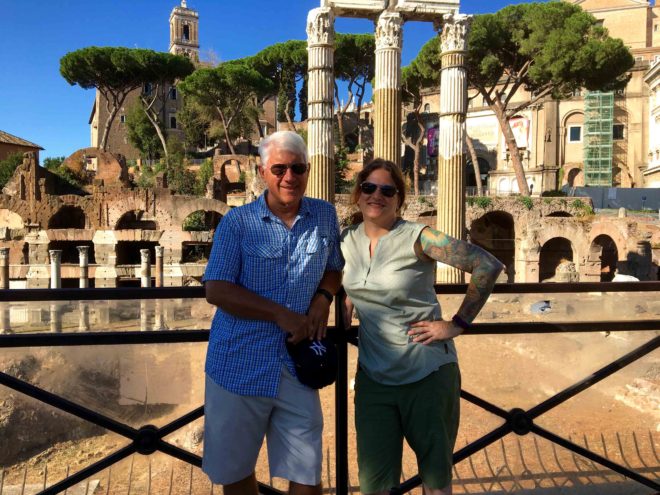
Jim and Michele aside the Roman Forum ruins.
We paused a bit at the Monument to Vittorio Emanuele II as it had been covered up for renovations when we were last in Rome.
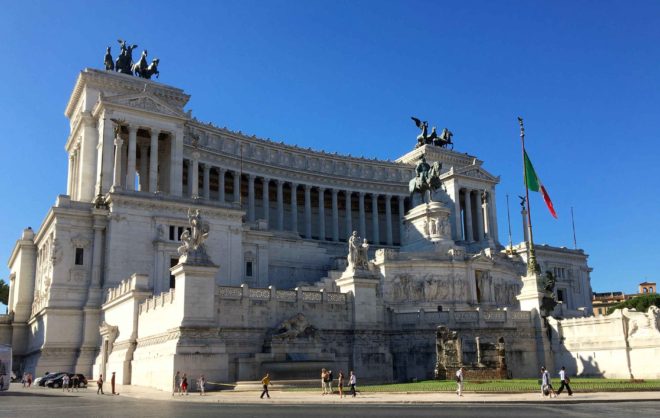
Monument to Vittorio Emanuele II on Piazza Venezia
Trevi Fountain was our next stop and as you’d expect, it is beautiful.
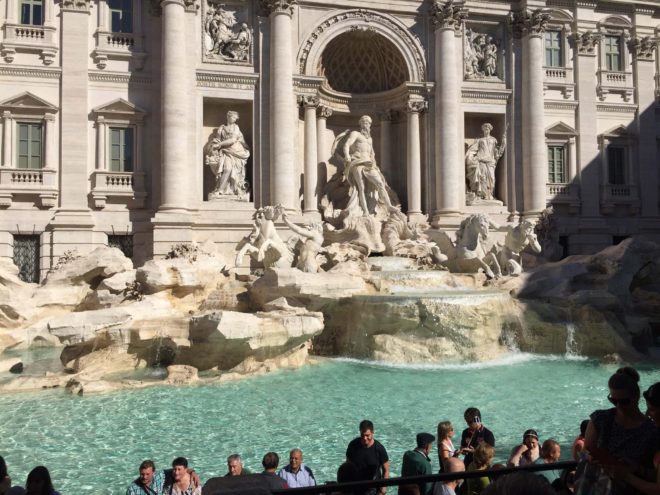
Trevi Fountain
From there, we visited the Spanish Steps, the Pantheon, the Temple of Adriano and Piazza Navona – perhaps our favorite piazza.
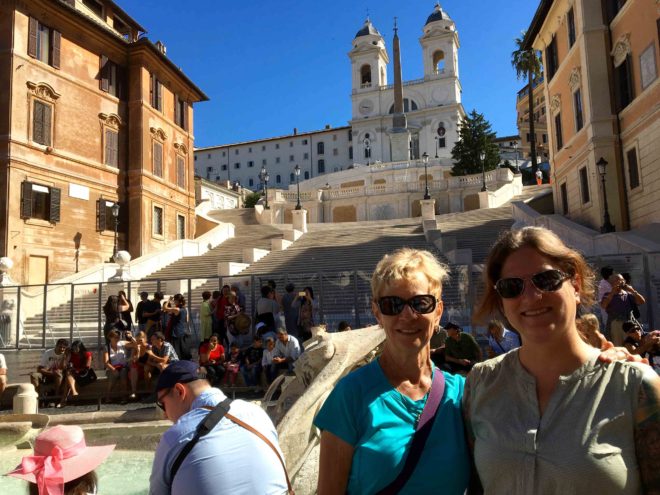
Michele & I posing at the bottom of the Spanish Steps. The 135 steps were built in 1725 & were intended to link the Spanish Embassy at the top with the Holy See which at the time, was off a plaza at the bottom of the stairs. The stairs were closed off the day we were there so we couldn’t climb them!
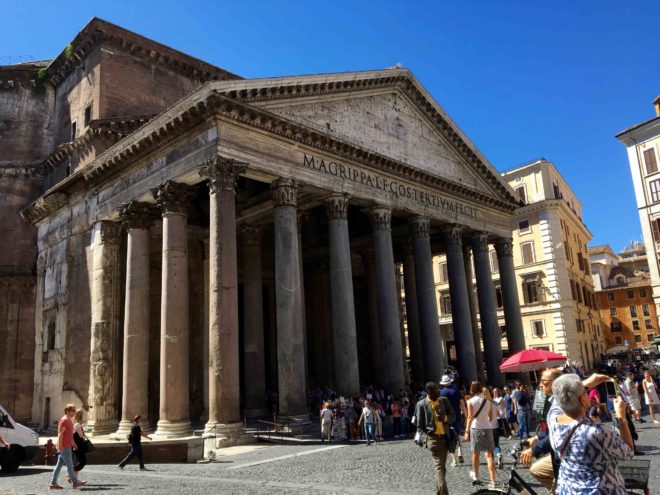
The Pantheon.
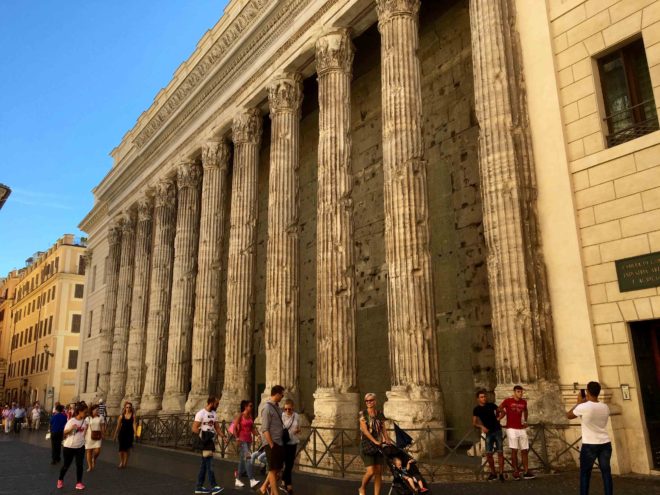
Only the ancient columns of the Temple of Adriano remain but they provide a remarkable facade for the newer building behind.

Piazza Novana at the Fountain of the Four Rivers and an ancient Egyptian obelisk. The four river gods represent a river on each of four major continents to which papal authority had spread in 1651: Nile (Africa), Danube (Europe), Ganges (Asia) and Rio de la Plata (Americas.)
We checked store fronts as we passed by but nothing grabbed our attention so we headed back to the ‘hood’ and another long, leisurely lunch. The day had been warm and sticky and by the time we headed back, it had even rained some. Not good for either my hair or Michele’s. Jim saved the day by locating a parrucchiere right around the corner from our apartment so Michele and I spent the next two or three hours being clipped, colored and otherwise groomed. And the price was slightly less than in the States.
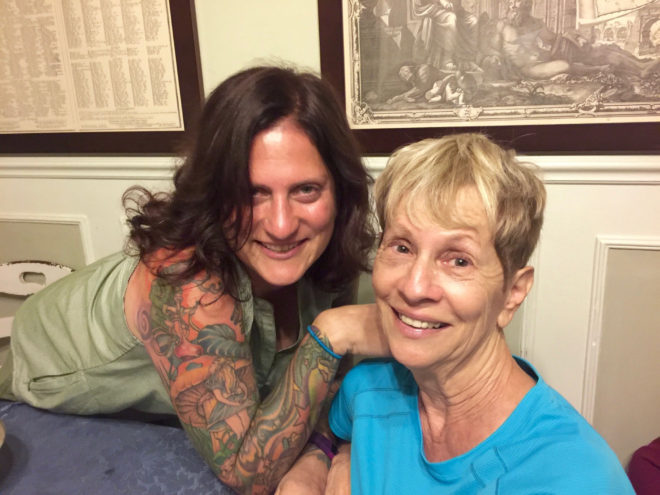
The neighborhood hairdressers did a great job. Check the Spanish Steps photo above to see what my hair looked like before this recovery — Michele’s as well!
The next day, Friday the 9th, we opted to remain together and began with a walk over to the Basilica of Santa Maria Maggiore, one of the “must see” entries in Simon’s to do list. Santa Maria Maggiore is one of only four Roman Catholic “major basilica’s” in the world and its interior is adorned with mosaics. Remnants of the manger or crib in which Jesus was laid after he was born are located in this church.

Basilica of Santa Maria Maggiore. This exterior can fool you but believe me, the church itself is through the arches you see here.
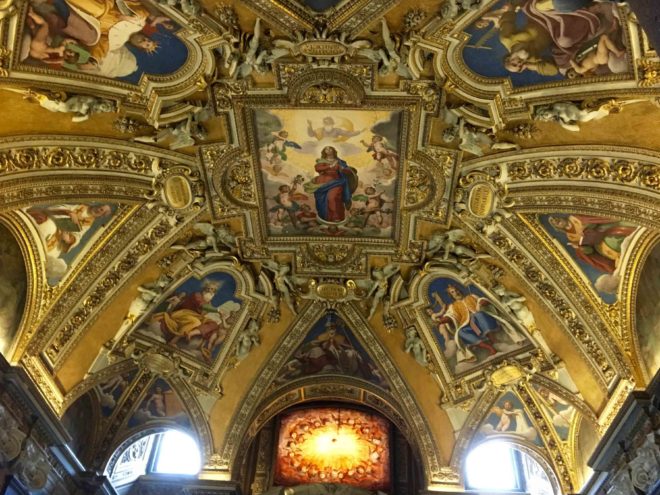
The elaborate ceiling in the dome above the altar. Santa Maria Maggiore was the first church actually dedicated to the Virgin Mary.
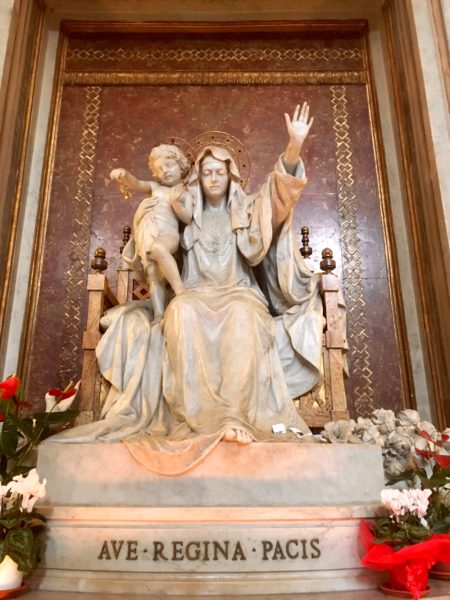
A beautiful shrine to Mary in the Basilica di S. Maria Maggiore — here, in Latin, “Hail the Queen of Peace.”
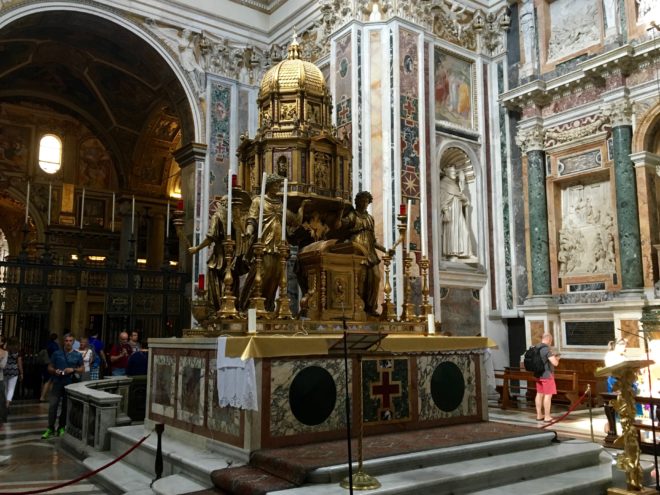
A center standing altar in the chapel dedicated to Pope Sixtus who was critical in establishing the church of Santa Maria Maggiore.
We learned that there is another church close by with even more beautiful mosaics — the Basilica di Santa Prassede — and since it was just one block over, that became our next target.
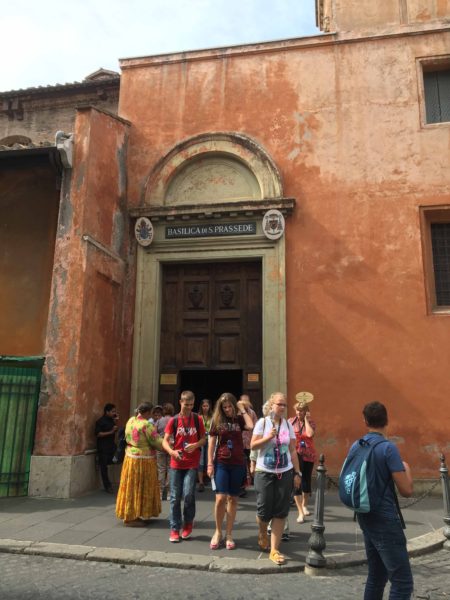
Entrance to the Basilica of Santa Prassede, somewhat hidden away from any main streets. And plain enough that most would not believe how much beauty is inside!
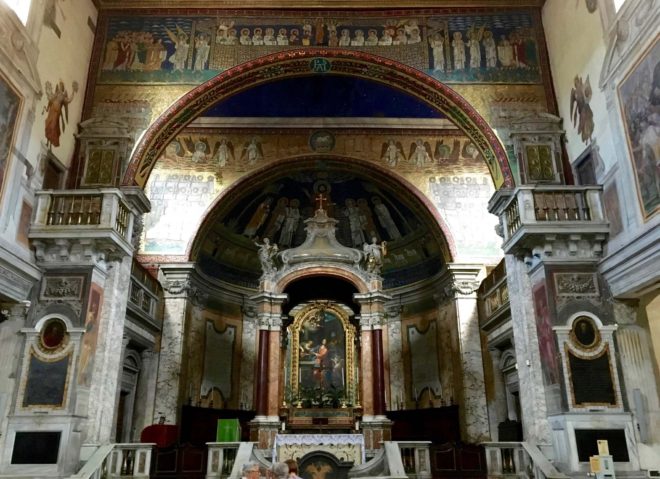
The main altar of S. Prassede. Look at the gold in the upper levels and in the arches.
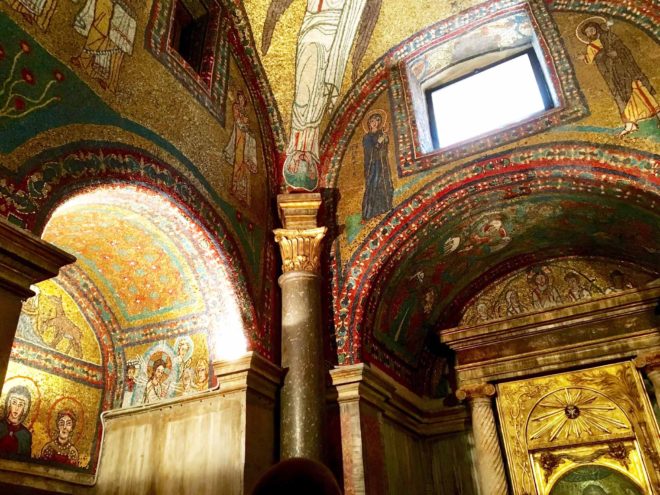
Truly awesome — this church reminded us of the Monreale Cathedral and the Cappella Palatina in Palermo.
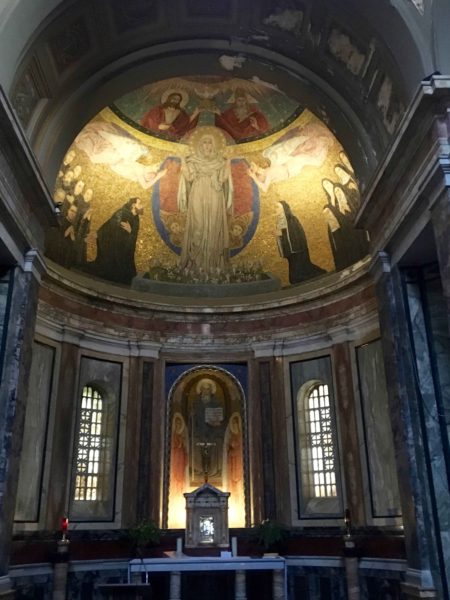
From another chapel in Santa Prassede. Wonder why we stop in so many churches? They are all different and all beautiful.
I am not so sure Santa Prassede wasn’t more beautiful than Santa Maria Maggiore. Once again, our timing set us up for a long lunch beginning around 2:00 PM and this would be our last pranzo with Michele and Simon. Needless to say, they did it up properly.
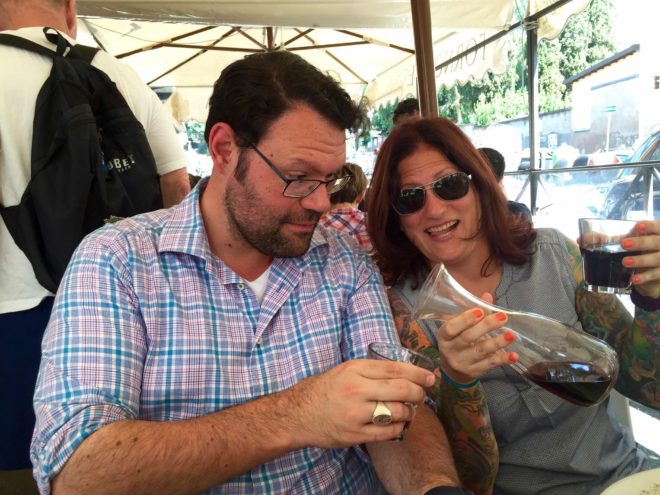
Last lunch in Rome for Simon and Michele. I think they have adapted well.
Domani, tomorrow, all four of us head to Rome’s Leonardo d’Vinci Aeroporto, those two to fly to Atlanta and Jim and me to fly to Palermo. We had a wonderful time with all the family that came to Italy to spend time mostly in Monteferrante, my mother’s family’s home, but also to see other parts of Italy. Connie split off to Scotland when we moved from Naples to Palermo the first time, and has been enjoying her time with son Brett and daughter-in-law Shelley. Michele and Simon stuck with us through this Rome venture and then left us. Fortunately, Chad and Juli are already in Sicily waiting for us to join them in Palermo. We’ll be back on the blog from Palermo. Ciao.